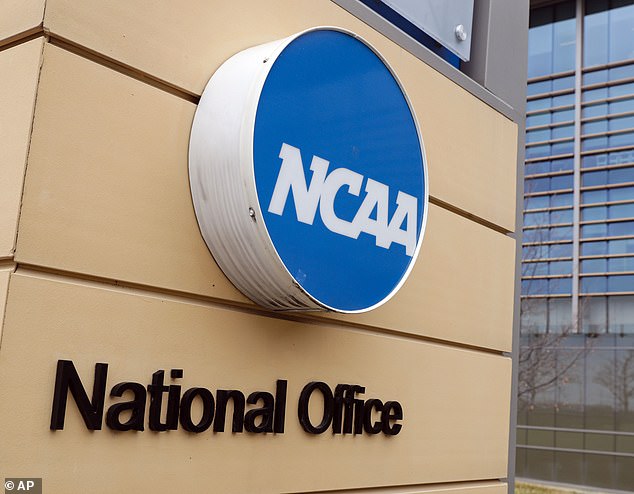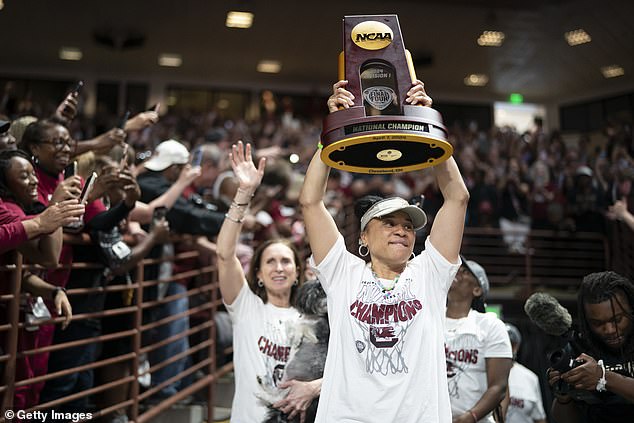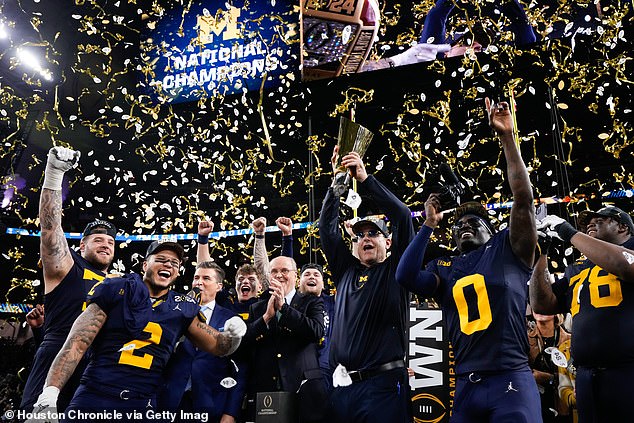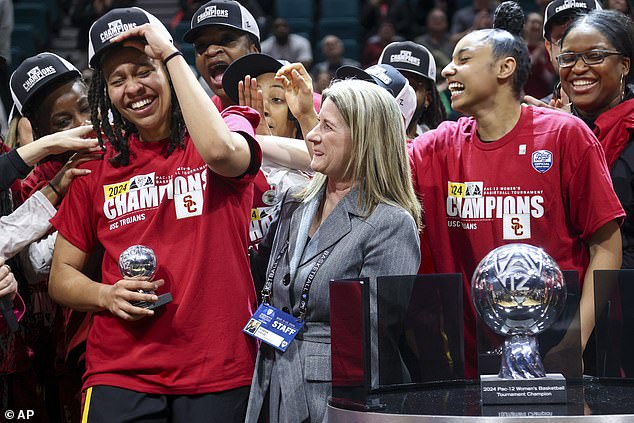NCAA paves way for colleges to pay student athletes for the first time EVER with new $2.8 BILLION anti-trust settlement agreement
The final barrier preventing colleges from paying student athletes appears to be on its last legs.
The NCAA and the nation’s five largest conferences announced Thursday evening that they have agreed to pay nearly $2.8 billion to settle a host of antitrust claims, a monumental decision that paves the way for a groundbreaking sharing model of revenue that could go into direct spending for millions of dollars. for athletes beginning in the fall 2025 semester.
NCAA President Charlie Baker, along with the commissioners of the Atlantic Coast Conference, Big Ten, Big 12, Pac-12 and Southeastern Conference, released a joint statement saying they had agreed to settlement terms. They called the move “an important step in the ongoing reform of college sports that will benefit student-athletes and provide clarity to college athletics across all divisions for years to come.”
The NCAA has resisted any form of compensation for athletes for years, but succumbed to mounting pressure in 2021 by allowing competitors to profit from their name, image and likeness (NIL).
Since then, some athletes, like former LSU gymnast Olivia Dunne, have made millions building their personal brands on social media, while other lower-profile players have been paid little or nothing.
Olivia Dunne of the LSU Tigers celebrates after winning the national championship in April

The NCAA and the nation’s five largest conferences announced Thursday evening that they have agreed to pay nearly $2.8 billion to settle a host of antitrust claims.
The deal must still be approved by the federal judge overseeing the case and challenges could arise, but if the agreement holds, it will mark the beginning of a new era in college sports where athletes are compensated more like professionals and schools can compete for talent using direct entry. payments.
‘There’s no doubt about it. It’s a huge leap forward,” said Tom McMillen, the former Maryland basketball player and congressman who has led an association of collegiate athletic directors for the past eight years.
The terms were not disclosed, although some details have emerged in recent weeks. They mark the end of the NCAA’s fundamental amateurism model, which dates back to its founding in 1906. The days of NCAA punishment for athletes who rode in cars with boosters began to disappear three years ago when the organization lifted the restrictions on endorsement deals, backed by so-called name, image and likeness money.

South Carolina coach Dawn Staley helped her players land $25,000 NIL deals
Now, it’s not far-fetched to look ahead to seasons where a star quarterback or a top player on a college basketball team not only cashes in big-money NIL deals but also has a $100,000 college payment in the bank to play.
“This groundbreaking settlement will bring college sports into the 21st century, with college athletes finally able to receive their fair share of the billions of dollars in revenue they generate for their schools,” said Steve Berman, one of the plaintiffs’ lead attorneys. . “Our customers are the foundation of the NCAA’s multi-billion dollar business and can finally be fairly and equitably compensated for their extraordinary athletic talents.”
Many details remain to be determined, but the agreement calls for the NCAA and its conferences to pay $2.77 billion over 10 years to more than 14,000 former and current college athletes who say now-defunct rules left them from monetizing its 2016 endorsement and sponsorship deals.
“Even if only because of overwhelming legal pressure, the NCAA, conferences and schools agree that college athletes should be paid,” said Ramogi Huma, a former UCLA football player and longtime advocate for college athletes. “And from there, there’s no going back. That is really groundbreaking.’
Some of the money will come from NCAA reserve funds and insurance, but while the lawsuit specifically targeted five conferences made up of 69 schools (including Notre Dame), dozens of other NCAA member schools will receive smaller payouts from the NCAA to cover the gigantic disease. payout.
Schools in the Big Ten, Big 12, Atlantic Coast and Southeastern conferences will ultimately bear the brunt of the settlement, to the tune of approximately $300 million each over 10 years, most of which will be awarded to athletes in the future will be paid.
The Pac-12 is also part of the settlement, with all 12 current schools sharing responsibility, even though Washington State and Oregon State will be the only league members left this fall after the other 10 schools leave.

Michigan Wolverines head coach Jim Harbaugh raises the championship trophy
Under the new compensation model, each school will be allowed, but not required, to set aside up to $21 million in revenue to share with athletes per year, but as revenues rise, that could also increase the cap.
Athletes in all sports would be eligible for payments and schools would be given the freedom to decide how that money is distributed among sports programs. Scholarship limits per sport will be replaced by roster limitations.
Whether the new compensation model falls under the Title IX Gender Equity Act is unknown, as is whether schools will be able to bring NIL activities in-house, as they hope, and the booster-run collectives that have emerged in recent years. to squeeze out. pay athletes. Both topics could lead to more lawsuits.
The resolution agreed in the settlement is a milestone, but not surprising. College sports have been moving in this direction for years, with athletes receiving more and more monetary benefits and rights that they say are long overdue.

Southern California’s McKenzie Forbes reacts after winning the Pac-12 Tournament in March
In December, Baker, the former governor of Massachusetts who has been in office for 14 months, proposed creating a new level of Division I athletics in which the most resourced schools would pay at least half of their athletes $30,000 a year must pay. That suggestion, along with many other possibilities, remains up for debate.
The settlement does not make all the problems facing college sports go away. There is still the question of whether athletes should be considered employees of their school, something Baker and other athletic leaders are fighting against.
Some form of federal legislation or antitrust relief is likely still needed to codify the terms of the settlement, protect the NCAA from future lawsuits and pre-empt state laws that seek to neutralize the organization’s authority. The NCAA continues to face lawsuits questioning its ability to govern itself, including enacting rules limiting multiple transfers.
It’s unclear what impact Thursday’s announcement will have on NIL deals, which have come to dominate college sports.
